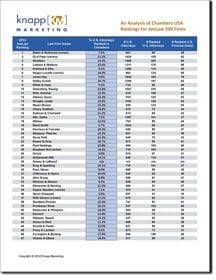The 2014 edition of this study can be found here.
Over the past six weeks, the Knapp Marketing team has conducted a research project to identify the percentage of attorneys listed in Chambers USA in the recently published Chambers USA Guide (June 2012). Please see our methodology in the last paragraph of this post. (Click here to see our most recent analysis, from 2014.)
We created a chart showing, by Am Law 200 rank, each firm’s percentage of US attorneys ranked in Chambers USA 2012. In addition, we have included the actual number of attorneys ranked and practice areas ranked.
Click here to open a PDF of the analysis results.
One could argue that this is a pointless activity, from the perspective of directories being of questionable worth to the questionable value of comparing these percentages. Why do it?
Aileen Hinsch joined Knapp Marketing in February 2012 with a strong expertise in in helping law firms improve their representation in Chambers USA and other directories. As my clients came to understand Aileen’s expertise, they began to request meetings to discuss their processes and success rates.
As we prepared for those meetings, I was looking for some baseline measure of how each firm was currently doing, and the idea of creating a percentage of the number of listed attorneys compared to total attorneys was born. One client firm who wanted to discuss their process already had over 12% of attorneys listed. Doing pretty well in my estimation. Another client had just under 7%, and we suspected their process could be improved.
When clients seemed pretty interested in hearing their percentage as compared to that of competitive firms, we decided to publish these results for the full Am Law 200.
As an aside: Three separate CMOs and Marketing Directors speaking with us in recent months had received RFPs that asked how many attorneys who would work on this matter are listed in Chambers. When the clients care, the law firms care.
Now, let me share all the ways in which our survey results can’t be taken at face value, and in fact, should be taken with a grain big lump of salt.
- Many highly respected firms with the most sophisticated practices have lower percentages of representation because they have only one office in New York, a state that has an insanely competitive Chambers ranking process. No slight to the Midwest, but Minnesota doesn’t have the same competition for attorney rankings as New York City. (Thanks to Mary K. Young of Zeughauser for this good observation.)
- Partners – not associates – are traditionally listed in Chambers, so highly leveraged practices may also have an artificially deflated percentage in our survey. As Ezra Crawford of BuckleySandler pointed out, a fairer measure would probably be the percentage of partner representation in Chambers. That is beyond our desire to count, but it’s a valid point nonetheless.
- Because we included statewide and national rankings, firms that have numerous smaller offices rather than several large offices might have an unfair advantage. That argument could certainly be made. However, students of the Am Law 100 will probably notice that some large firms with only several offices still have high percentages.
- Firms with a strong focus on a narrow number of practices have fewer opportunities to submit for practice categories, and so may be unfairly represented in this survey.
- Chambers has been criticized for undervaluing transactional legal work, and editor Laura Mills has said that the guide and researchers are seeking to remedy that. If yours is a litigation or strongly transactionally based firm, this could adversely affect your number of rankings.
So now that we’ve talked about how you shouldn’t use this listing, let me tell you how it can be used. A judicious comparison of your firm’s percentage to that of your true competitor firms can give you a sense of how you are doing in Chambers. A low percentage can indicate that (1) your firm and attorneys don’t care about Chambers [in which case expect an influx of legal marketing resumes soon] (2) your process could use some tweaking to produce more and better submissions (3) your attorneys aren’t giving you their best thinking and strategy on how to position their practices as uniquely successful.
Methodology
This analysis is based on the reporting in The 2012 Am Law 200 and Chambers USA 2012. In order to arrive at our percent of lawyers listed in Chambers USA, we began with the attorney head count in the Am Law 200 and subtracted the number of lawyers listed in non-USA offices on the law firm’s website. The resulting number became our ‘total number of US lawyers’ for each firm. Then, we counted the number of attorneys listed in Chambers USA, both in national and state categories and divided that by the total number of US attorneys. For reference, our analysis chart includes the number of individual attorneys and practices listed in Chambers USA for each firm.
Thanks for my team members @AileenHinsch, @SamTaraCollier, Elaine Noble and Heather Davis for their work on this project.


